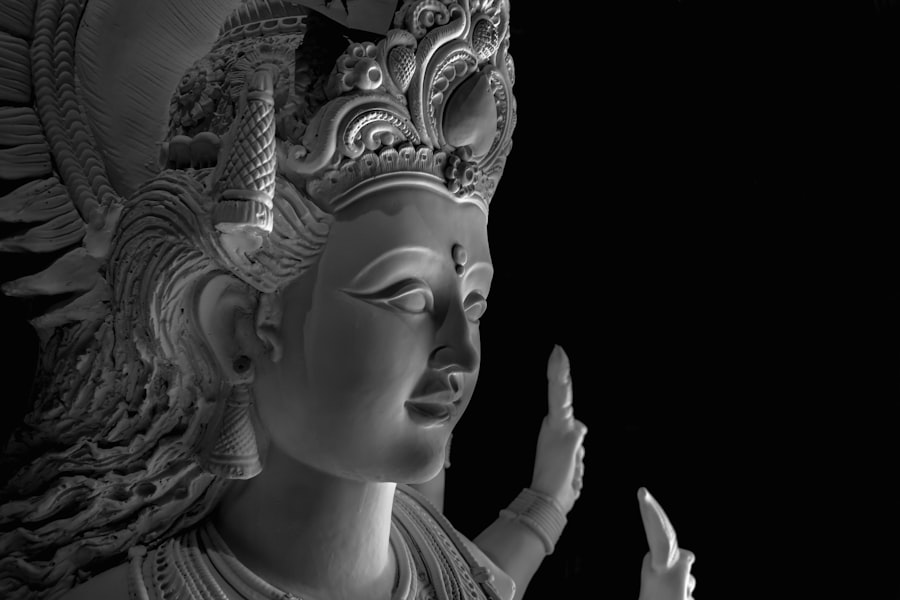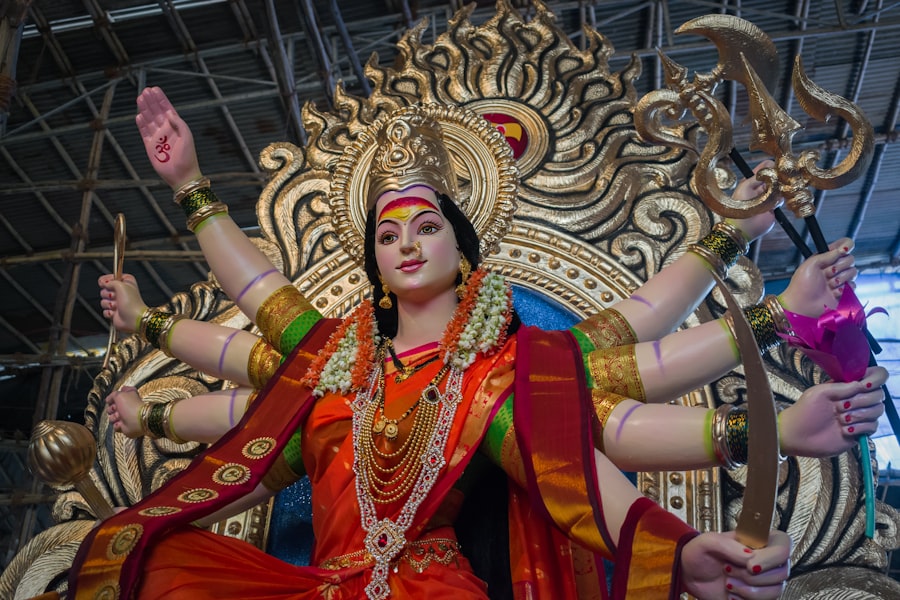Durga, also known as Devi or Shakti, is a prominent goddess in Hinduism, embodying feminine energy and revered as the mother of the universe. She is typically depicted as a warrior goddess, riding a lion and carrying various weapons, symbolizing her strength and protective nature. Durga plays a significant role in Hindu mythology and is celebrated in numerous festivals and rituals throughout the year.
According to Hindu beliefs, Durga was created as a combined form of all divine energies from the gods to defeat the demon Mahishasura. Her name, meaning “the invincible” in Sanskrit, reflects her power and ability to overcome challenges. She is also known by other names such as Parvati, Ambika, and Bhavani, each representing different aspects of her divine nature.
Devotees seek Durga’s blessings for strength, protection, and guidance. She is worshipped in various forms across India and holds a central position in Hindu religious practices.
Key Takeaways
- Durga is a powerful goddess in Hinduism, known for her strength and protection.
- The iconography of Durga often depicts her with multiple arms, riding a lion, and holding various weapons.
- Durga’s mythology and legends often involve her defeating powerful demons and restoring balance to the world.
- The weapons and accessories of Durga symbolize her ability to destroy evil and protect her devotees.
- Durga is revered as the divine mother and protector, embodying love, compassion, and fierce determination.
The Iconography of Durga
Iconic Image and Symbolism
Durga is often depicted with multiple arms, each holding a different weapon or symbol. Her iconic image shows her riding a lion, symbolizing her courage and fearlessness. She is adorned with various ornaments and garments, signifying her divine beauty and grace.
Divine Nature and Attributes
Durga’s complexion is often depicted as golden or radiant, representing her divine nature and purity. Her eyes are said to be fierce and powerful, reflecting her ability to see through illusions and protect her devotees from harm. The weapons that Durga holds in her hands are symbolic of her ability to vanquish evil forces and protect the universe.
Symbolism of Weapons and Objects
The trident she wields represents the three qualities of sattva (goodness), rajas (passion), and tamas (ignorance), which she transcends with her divine power. The sword symbolizes knowledge and wisdom, which she uses to cut through ignorance and dispel darkness. The bow and arrow represent her ability to focus her energy and strike down negativity with precision. The conch shell she holds signifies the primordial sound of creation, while the lotus flower represents purity and spiritual enlightenment.
Protector and Nurturer
Durga’s iconic image is a visual representation of her divine attributes and her role as a protector and nurturer.
The Mythology and Legends of Durga

The mythology of Durga is rich with stories of her battles against demons and her role as a protector of the gods and the universe. One of the most famous legends about Durga is the story of her battle with the buffalo demon Mahishasura. According to the myth, Mahishasura had obtained a boon from Brahma, which made him invincible against any man or god.
With his newfound powers, he began to wreak havoc on the earth and heaven, causing chaos and destruction. The gods, unable to defeat him, combined their energies to create Durga, who was endowed with their divine weapons and qualities. Durga engaged in a fierce battle with Mahishasura for nine days and nights, ultimately slaying him with her trident.
This victory is celebrated annually during the festival of Navaratri, which honors Durga’s triumph over evil. Another popular legend about Durga is her battle with the demon Raktabija, who had the power to create a new demon from every drop of his blood that fell to the ground. Durga overcame this challenge by creating Kali, another fierce goddess who drank Raktabija’s blood before it could spawn new demons.
These stories illustrate Durga’s role as a powerful warrior goddess who vanquishes evil forces and protects the universe from destruction.
The Symbolism of Durga’s Weapons and Accessories
| Weapon/Accessory | Symbolism |
|---|---|
| Trishul (Trident) | Represents the three fundamental aspects of life – creation, maintenance, and destruction |
| Chakra (Discus) | Symbolizes the eternal cycle of time and the cosmic order |
| Conch Shell | Represents the sound of the cosmic creation and the divine Om |
| Bow and Arrow | Symbolizes energy and the ability to focus the mind |
| Sword | Represents knowledge and the ability to cut through ignorance |
| Lotus | Symbolizes purity and divine beauty |
| Thunderbolt | Represents firmness and the power to overcome obstacles |
The weapons and accessories that Durga is depicted with hold deep symbolic significance in Hindu mythology. The trident she wields represents her ability to overcome the three gunas or qualities that bind humans to the cycle of birth and death. Sattva represents purity and knowledge, rajas represents passion and activity, and tamas represents ignorance and inertia.
By transcending these qualities, Durga embodies divine wisdom and purity, guiding her devotees towards spiritual enlightenment. The sword that Durga carries symbolizes knowledge and wisdom, which she uses to cut through ignorance and dispel darkness. It represents her ability to discern truth from illusion and to protect her devotees from harm.
The bow and arrow she holds signify her focused energy and precision in striking down negativity and evil forces. The conch shell she carries represents the primordial sound of creation, symbolizing her role as the source of all existence. The lotus flower she holds signifies purity and spiritual enlightenment, reminding her devotees of the divine grace she bestows upon them.
Durga as the Divine Mother and Protector
Durga is revered as the divine mother in Hinduism, embodying love, compassion, and nurturing care for all beings. She is often depicted with a gentle expression on her face, symbolizing her maternal nature and unconditional love for her devotees. Durga is believed to protect her devotees from harm and guide them towards spiritual growth and enlightenment.
Her role as a mother figure is central to her worship, as devotees seek her blessings for strength, protection, and guidance in their lives. Durga’s fierce form as a warrior goddess also reflects her protective nature towards those who seek refuge in her. She is often called upon in times of distress or danger, as she is believed to swiftly come to the aid of those who call upon her with sincerity and devotion.
Her role as a protector extends beyond physical harm to include protection from negative influences, ignorance, and spiritual obstacles. Devotees of Durga turn to her for solace, strength, and guidance in navigating life’s challenges, knowing that she will always be there to shield them from harm.
Durga in Contemporary Hinduism

Symbolism and Devotion
Her images are prominently displayed in homes, businesses, and public spaces as a symbol of protection and auspiciousness. Devotees of Durga often recite hymns and prayers dedicated to her, seeking her blessings for strength, protection, and guidance in their lives. Many also observe fasts and perform acts of charity during festivals dedicated to Durga as a way of showing devotion and seeking her favor.
Cultural Influence
In addition to religious practices, Durga’s influence can be seen in various art forms such as music, dance, drama, and literature that celebrate her divine attributes and role as a protector and nurturer.
Lasting Impact
Through her multifaceted presence, Durga continues to inspire and empower individuals, fostering a sense of community and cultural identity among Hindus around the world.
The Celebration of Durga in Festivals and Rituals
The celebration of Durga takes center stage during the festival of Navaratri, which lasts for nine nights and ten days. Each day of Navaratri is dedicated to one of Durga’s nine forms or manifestations, known as Navadurga. Devotees observe fasts, perform rituals, recite prayers, sing hymns, and participate in cultural events during this auspicious period.
The tenth day of Navaratri is celebrated as Vijayadashami or Dussehra, marking the triumph of good over evil. Another important festival dedicated to Durga is Durga Puja, which is widely celebrated in West Bengal and other parts of India with great fervor and enthusiasm. Elaborate pandals or temporary structures are erected to house beautifully crafted idols of Durga along with those of other deities.
The festival involves vibrant processions, cultural performances, feasting, and rituals that honor Durga’s victory over Mahishasura. In addition to these major festivals, there are numerous regional celebrations dedicated to Durga throughout India that showcase diverse customs, traditions, and rituals associated with her worship. These festivals serve as occasions for communal harmony, cultural exchange, and spiritual renewal as devotees come together to honor Durga’s divine presence in their lives.
In conclusion, Durga holds a significant place in Hinduism as a powerful goddess who embodies strength, protection, and divine grace. Her iconic image reflects her role as a warrior goddess who vanquishes evil forces while also embodying maternal love and compassion for all beings. The mythology surrounding Durga’s battles against demons illustrates her unwavering commitment to protecting the universe from destruction.
In contemporary Hinduism, she continues to be revered through festivals, rituals, prayers, and cultural expressions that honor her divine presence in the lives of devotees. As a symbol of feminine power and divine protection, Durga remains an enduring source of inspiration for millions of Hindus around the world.
If you are interested in learning more about Hindu symbolism and mythology, you may want to check out this article on the Temple Yatri website about the mystical Vedadri Narasimha Temple. The article explores the significance of the temple and its connection to Hindu mythology, offering a deeper understanding of the symbolism and beliefs within the religion. You can read the full article here.
FAQs
What is the significance of Durga in Hinduism?
Durga is a powerful and fierce goddess in Hinduism, known for her strength and protection. She is revered as the divine mother and represents the feminine energy in the universe.
What does Durga symbolize in Hinduism?
Durga symbolizes the victory of good over evil, as she is often depicted slaying the buffalo demon, Mahishasura. She also represents courage, strength, and the ability to overcome obstacles.
What are the different forms of Durga?
Durga is worshipped in various forms, including Parvati, Ambika, Kali, and Chandi. Each form represents different aspects of the goddess, such as motherly love, ferocity, and protection.
How is Durga typically depicted in Hindu art and iconography?
Durga is often depicted riding a lion or tiger, carrying weapons in her multiple arms, and wearing a serene yet powerful expression. She is adorned with traditional symbols of strength and protection, such as a trident and a conch shell.
What are the major festivals associated with Durga in Hinduism?
The most prominent festival dedicated to Durga is Navaratri, a nine-night celebration that honors the goddess in her various forms. Another important festival is Durga Puja, which is widely celebrated in the Indian state of West Bengal.
